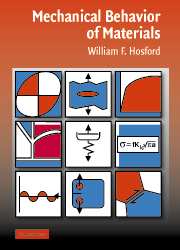Book contents
- Frontmatter
- Contents
- Preface
- Note to the Reader
- 1 Stress and Strain
- 2 Elasticity
- 3 Tensile Testing
- 4 Other Tests of Plastic Behavior
- 5 Strain-Hardening of Metals
- 6 Plasticity Theory
- 7 Strain-Rate and Temperature Dependence of Flow Stress
- 8 Slip
- 9 Dislocation Geometry and Energy
- 10 Dislocation Mechanics
- 11 Mechanical Twinning and Martensitic Shear
- 12 Hardening Mechanisms in Metals
- 13 Ductility and Fracture
- 14 Fracture Mechanics
- 15 Viscoelasticity
- 16 Creep and Stress Rupture
- 17 Fatigue
- 18 Residual Stresses
- 19 Ceramics and Glasses
- 20 Polymers
- 21 Composites
- 22 Mechanical Working
- Appendix A Miller Indices
- Appendix B Stereographic Representation of Orientations
- Index
4 - Other Tests of Plastic Behavior
Published online by Cambridge University Press: 05 June 2012
- Frontmatter
- Contents
- Preface
- Note to the Reader
- 1 Stress and Strain
- 2 Elasticity
- 3 Tensile Testing
- 4 Other Tests of Plastic Behavior
- 5 Strain-Hardening of Metals
- 6 Plasticity Theory
- 7 Strain-Rate and Temperature Dependence of Flow Stress
- 8 Slip
- 9 Dislocation Geometry and Energy
- 10 Dislocation Mechanics
- 11 Mechanical Twinning and Martensitic Shear
- 12 Hardening Mechanisms in Metals
- 13 Ductility and Fracture
- 14 Fracture Mechanics
- 15 Viscoelasticity
- 16 Creep and Stress Rupture
- 17 Fatigue
- 18 Residual Stresses
- 19 Ceramics and Glasses
- 20 Polymers
- 21 Composites
- 22 Mechanical Working
- Appendix A Miller Indices
- Appendix B Stereographic Representation of Orientations
- Index
Summary
Introduction
Necking limits uniform elongation in tension, making it difficult to study plastic stress–strain relationships at high strains. Much higher strains can be reached in compression, torsion, and bulge tests. The results from these tests can be used, together with the theory of plasticity (Chapter 6), to predict stress–strain behavior under other forms of loading. Bend tests are used to avoid the problem of gripping brittle material without breaking it. Hardness tests eliminate the considerable time and effort required to machine tensile specimens. Also, hardness tests are simple to perform and are not destructive.
Compression test
Much higher strains are achievable in compression tests than in tensile tests. However, two problems limit the usefulness of compression tests: friction and buckling. Friction on the ends of the specimen tends to suppress the lateral spreading of material near the ends (Figure 4.1). A cone-shaped region of dead metal (nondeforming material) can form at each end, with the result that the specimen becomes barrel shaped. Friction can be reduced by lubrication and the effect of friction can be lessened by increasing the height-to-diameter ratio, h/d, of the specimen.
- Type
- Chapter
- Information
- Mechanical Behavior of Materials , pp. 53 - 69Publisher: Cambridge University PressPrint publication year: 2005



